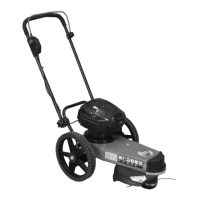18 DR
®
PILOT TRIMMER/MOWER
Use only the DR
®
62V Charger with DR
®
62V Battery Packs. Do not try to use the DR
®
62V Charger with Battery Packs from other
manufacturers.
Battery Pack and Charger information
The Battery Pack should not leak, regardless of the position in which it is stored. Read “Handling the Battery Pack and Charger
Safely” in Chapter 1 for important warning info. The Battery Pack is completely maintenance free. You never need to add water.
With all rechargeable Batteries, after years of use, they will eventually need replacement.
Recycling a Used Battery
1. Please dispose of your used Batteries responsibly by recycling them. Call your local Solid Waste Management District or your
local waste handler to locate the collection site nearest you. Some collection sites recycle Batteries year-round; others collect
them periodically.
2. You can also visit the Website of Earth 911 (www.earth911.com) for more information. Once there, click Recycle Guide at the
top of the page, then click the Municipal HHW link under Hazardous Household Waste, and enter your zip code. The site lists
recycling centers located near you.
3. For a fee, you can recycle your Batteries with the International Metals Reclamation Company. Visit them at www.inmetco.com
and click Services, then click Battery Recycling; or contact them at:
INMETCO,
One INMETCO Drive,
Ellwood City, PA 16117,
(724) 758-5515; fax (724) 758-2845.
To learn more about hazardous waste recycling, visit the Website for Battery Council International (www.batterycouncil.org) or for
the Environmental Protection Agency (www.epa.gov)
Make sure the Charger Power Supply is plugged into a normal household voltage, 120volts, 60Hz, AC only.
You should operate the Battery Charger in a dry place with temperatures between 50ºF (10ºC) and +100ºF (+37.8ºC).
Operating above +100 ºF can cause Battery Pack leakage, rust, or degradation of the Battery Pack performance.
Disconnect Charger Power Supply from the household voltage power when not in use to prevent damage to the Charger
during a power surge.
Periodically inspect the Cord on the Charger unit for damage. If damage occurs, do not use the Charger until you have
replaced or repaired the Cord. Do not abuse the Cord. Never carry the Charger by the Cord. Always pull the plug and not the
Cord when disconnecting the Power Supply from the electrical outlet (wall outlet) and from the Charger. When using an
extension Cord with your Charger, use a heavy-duty extension Cord of a type 'suitable for outdoor use' (although you should
never charge the Battery Pack in the open outdoors).
The Battery Pack requires 2-3 charging and discharging cycles before reaching full charge ability.
A Battery Pack may last much longer if you charge it as soon as it starts to lose power and not let it completely discharge.
Recharge the Battery Pack as soon as the trimming power of your machine is no longer effective. This would be a good time
to have a spare Battery Pack ready to go. Recharge the Battery Pack for up to 75 minutes or until fully charged and remove it
from the Charger.
A good time to consider purchasing a replacement Battery Pack is when it loses its power quickly.
Please dispose of used batteries responsibly, according to your local hazardous materials regulations. Never throw away used
batteries in your household trash.

